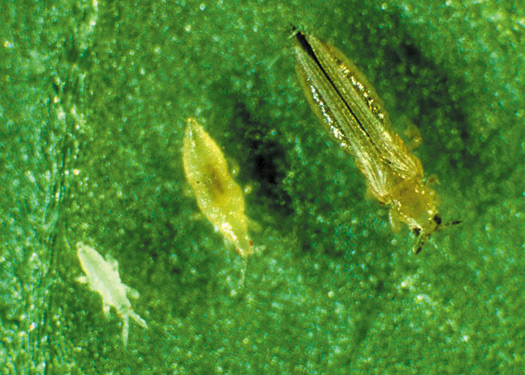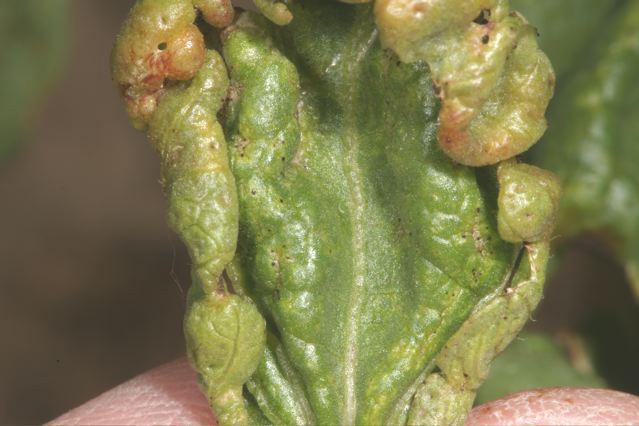Thrips
Thysanoptera
Thrips are probably the most consistent pest challenging Kansas cotton growers. Thrips are less than 2 millimeters long and vary in color from yellow to brown, gray or black. Adults have two pairs of narrow wings fringed with long hairs. These tiny, barely visible, splinter-like insects can cause significant injury during the first couple of weeks after plants emerge. Their feeding can retard plant growth, especially under dry conditions, but they are sometimes blamed for more damage than they cause. Thrips damage can also resemble spider mite damage, but without the webbing.
|
Western Flower Thrips, Frankliniella occidentalis. |
Cotton leaf damaged by thrips feeding. |
Most problems in Kansas are caused thrips migrating from maturing wheat to seedling cotton in the spring. A burst of thrips activity can be particularly damaging if it occurs when the cotton plants are just emerging from the soil. Thrips rasp tender leaves and terminal buds with their sharp mouthparts and then feed on the juices released. Leaves may turn brown on the edges, develop a silvery color, or become distorted and curl upward. Light thrips infestations tend to delay plant growth and retard maturity. Heavy infestations may kill terminal buds or even entire plants. Feeding damaged to terminal buds can cause abnormal branching patterns. The duration and intensity of thrips infestations vary greatly according to season and geographic location. Once cotton plants are four to six weeks old, they can easily outgrow thrips damage and recover.
|
Leaf damage caused by thrips. |
Although scouting for thrips is quite difficult, it is important to detect significant populations before economic damage occurs, as it can accumulate very quickly. Start looking for thrips as soon as plants begin to emerge, especially on the newest growth. Working on hands and knees, shake plants over a piece of white paper. If you see small, slender objects crawling, these are usually thrips. Any residues of sand or soil on the plants will make the thrips more difficult to see. Windy conditions may require pulling up some plants, placing them in a plastic bag, and taking them into a vehicle to examine the terminals and youngest leaves for thrips under sheltered conditions. Treatment may be justified if there are more than 1 thrips per true leaf up to the 6 leaf stage, depending on growing conditions. Control is rarely necessary later in the season.
Chemical efficacy will vary according to the species of thrips. If one product does not seem to work, try a different insecticide. If cotton ssed is treated with a systemic insecticide at planting, it should be scouted for thrips two weeks after plants emerge. If live, immature thrips are found, it means that thrips are laying eggs in the field and that the seed treatment is no longer protecting the plants; a follow-up foliar application may be necessary.
Most problems in Kansas are caused thrips migrating from maturing wheat to seedling cotton in the spring. A burst of thrips activity can be particularly damaging if it occurs when the cotton plants are just emerging from the soil. Thrips rasp tender leaves and terminal buds with their sharp mouthparts and then feed on the juices released. Leaves may turn brown on the edges, develop a silvery color, or become distorted and curl upward. Light thrips infestations tend to delay plant growth and retard maturity. Heavy infestations may kill terminal buds or even entire plants. Feeding damaged to terminal buds can cause abnormal branching patterns. The duration and intensity of thrips infestations vary greatly according to season and geographic location. Once cotton plants are four to six weeks old, they can easily outgrow thrips damage and recover.
Although scouting for thrips is quite difficult, it is important to detect significant populations before economic damage occurs, as it can accumulate very quickly. Start looking for thrips as soon as plants begin to emerge, especially on the newest growth. Working on hands and knees, shake plants over a piece of white paper. If you see small, slender objects crawling, these are usually thrips. Any residues of sand or soil on the plants will make the thrips more difficult to see. Windy conditions may require pulling up some plants, placing them in a plastic bag, and taking them into a vehicle to examine the terminals and youngest leaves for thrips under sheltered conditions. Treatment may be justified if there are more than 1 thrips per true leaf up to the 6 leaf stage, depending on growing conditions. Control is rarely necessary later in the season.
Chemical efficacy will vary according to the species of thrips. If one product does not seem to work, try a different insecticide. If cotton ssed is treated with a systemic insecticide at planting, it should be scouted for thrips two weeks after plants emerge. If live, immature thrips are found, it means that thrips are laying eggs in the field and that the seed treatment is no longer protecting the plants; a follow-up foliar application may be necessary.
Please refer to the most recent Cotton Insect Management Guide for material rates and control options.
Page last updated 05/13/2024 by J.P. Michaud.


